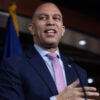Let’s take a closer look at how the Obama Administration demonstrates “efficiency” and “economy” in actual practice. Fair warning: It ain’t pretty.
New rules (supposedly) intended to maximize the services of government contractors require such firms to give first preference in hiring to the workers of the company that lost the contract. That is, when a government contract is awarded to a different firm, this new contractor must first offer employment to the workers of the previous contractor before hiring anyone else. As delineated in the Federal Register of August 29, tens of thousands of companies—representing more than $23 billion in government contracting—will be affected.
According to the U.S. Department of Labor, which issued the new regulation, “The Federal Government’s procurement interests in economy and efficiency are better served when a successor contractor hires the predecessor’s employees.”
Oh, really?
That certainly doesn’t appear to be the case. Even by Labor Department estimates, complying with the myriad hiring rules will cost government contractors tens of millions of dollars. Those additional costs are ultimately borne by taxpayers in the form of higher contract costs.
And, to the extent that the rules dissuade firms from bidding for government business—some business owners just might want to make their own hiring decisions—a smaller pool of contractors will raise the price floor.
But that’s not all.
The rule effectively ensures that a non-unionized contractor cannot replace a unionized one. That’s because any new contractor will be obliged to hire its predecessors’ unionized workers, and thus forced by the “Successorship Doctrine” to bargain with the union(s). Insulating union wages from market competition will also escalate the costs of government contracts.
The new rule implements provisions of Executive Order 13495, issued by President Obama on January 30, 2009.
All of which adds up to a taxpayer shafting of egregious proportions. That the government attempts to masquerade this union payoff as “economic and efficient” just makes the whole sorry exercise all the more unseemly.
#2: The EPA Is Fueling Nonsense
#4: The Unwitting Peddlers of Toxic Tomes
#5: Calorie Counts Forced Down Our Throats
#6: Equine Equality Under the ADA
#7: Energy Department Plumbing for More Regulatory Powers
#8: How Many Hazmat Suits Does It Take to Change a Light Bulb?
#9: Regulators Going Off on Microwave Ovens
#10: The State Department’s Passport Inquisition
#11: Circumcising Principle in San Francisco
#12: Regulatory Grapes of Wrath
#13: An “F” for Train Regulation
#14: Old MacDonald’s Commodity Cartel
#15: More Regulatory Manure from USDA
#16: Tackling Serious Matters in Washington, D.C.
#17: A Myopic Regulatory Vision
#18: Americans Take a Regulatory Bleating































2 Replies to “Tale of the Red Tape #19: A More Perfect Union Advantage”